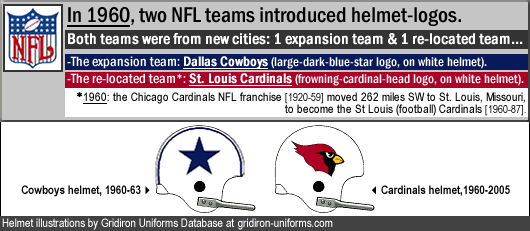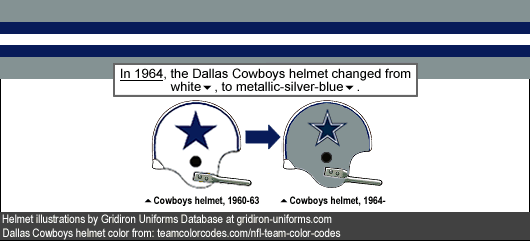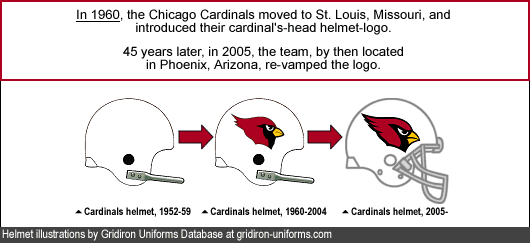
American Football League: 1960 AFL season, map with helmets/jerseys and final standings + offensive stats leaders; champions: Houston Oilers
…
…
By Bill Turianski on 24 September 2018; twitter.com/billsportsmaps.
Links…
-1960 AFL season
-1960 AFL Championship Game (en.wikipedia.org).
-1960 AFL season (pro-football-reference.com).
The map… The map shows the 8 teams in the inaugural season of the American Football League (IV) (1960). At the lower-right of the map-page are the final standings of the 1960 AFL, along with home jerseys and helmets of the 8 AFL teams of 1960. At the bottom-right corner are the attendance figures for the 1960 AFL. The map lists all 8 original venues of the 8 charter members of the AFL, and it shows every location that the 8 original AFL teams have played in (1960-69 in AFL, 1970-2018 in NFL). At the upper-right of the map-page are standout players for the champions, the 1960 Houston Oilers. Below that are 1960 AFL offensive leaders in the following categories: Passing Yardage, Frank Tripucka, Denver Broncos. QB Rating, Tom Flores, Oakland Raiders. TD Passes, Al Dorow, New York Titans. Rushing Yardage and Yards from Scrimmage, Abner Haynes, Dallas Texans. Receiving Yards, Bill Groman, Houston Oilers. Total TDs, Art Powell, New York Titans.
…
The AFL versus the NFL…
In the late 1950s, just as the NFL was becoming a vastly popular sporting entertainment to millions of Americans, here is what the 12-team NFL thought about expansion, as represented by a quote from the Washington owner George Preston Marshall: “There is no excuse for expansion in the National Football League. We furnish football now, for free, through television. Expansion can only weaken the personnel.” The AFL proved this to be a fallacy. Principal founder of the AFL Lamar Hunt, co-founder Bud Adams, the other AFL owners, and all the players who played in the AFL, would prove that there was plenty of room for more pro football teams in America.
In 1960, the AFL started with 8 teams, and the eight ownership groups were dubbed “the Foolish Club”.
To a man, the NFL front office, as well as the front offices of all the 12 established NFL teams, were quite sure the AFL would soon be a bust. But by the mid-1960s, the NFL had realized that the AFL was for real. By the close of the 1965 season, the American Football League, after 6 seasons, had basically become a significant rival to the NFL. The AFL had increased its attendance remarkably. The AFL went from averaging 16 K per game in their first season in 1960, to averaging 31 K per game five years later in 1965. The AFL’s television contract with NBC, and the several major stadiums being built for AFL teams, were indications that in the late 1965/early 1966 time period, the AFL was starting to look like it was a success, a success that could only threaten the NFL. And the AFL was planning on expansion [the Miami Dolphins joined the AFL in 1966 and the Cincinnati Bengals became the 10th AFL team in 1968].
The AFL had a ten-year battle with the NFL that saw the AFL gradually gain more popularity, as the decade of the 1960s wore on. The first indication that the new AFL might be able to challenge the NFL was when the Houston Oilers signed 1959 Heisman Trophy winner Billy Cannon [of LSU], despite the fact that the NFL’s Los Angeles Rams had signed Cannon two months earlier (the Oilers owner Bud Adams had offered Cannon $3,000 more per season plus a Cadillac). In June 1960, the Oilers’ record-breaking $110,000 contract with Cannon was upheld in court, and the AFL had poached the biggest prospect from out of the hands of the NFL. (The speedy Cannon went on to be the MVP of the 1960 AFL Championship Game {see illustration at the end of this post}.)
A major way in which the AFL was able grab the attention of sports fans was its style of play.
While the NFL of this era centered on the stodgy running game, the AFL was based on the decidedly more exciting passing game, throwing downfield play after play. Visionary head coach Sid Gillman of the Chargers introduced the vertical offense, stretching the football field by throwing deep downfield passes, instead of short passes. Gillman and his proteges were instrumental in making football into the modern game that it is today. But it wasn’t just the Chargers that were emphasizing the passing game in the new AFL: most teams there were doing it. And the league’s first champions, the Houston Oilers, under head coach Lou Rymkus, won titles with an aggressive passing game.
Rejected NFL QB George Blanda came out of retirement to join the Houston Oilers as a 33-year-old.
Blanda had been QB/K for the Chicago Bears from 1950-58, but he retired when he learned that George Halas intended to demote him to only placekicking duties. So when the AFL got started up, Blanda realized he could get another shot as a starting QB. And so, in 1960 and ’61, Blanda led the Houston Oilers to the first two AFL titles, setting a TD passing record that stood for 23 years. Blanda threw 36 TD passes in 1961. (That record was matched by YA Tittle of the NFL’s New York Giants two years later in 1963, and was not beaten until the NFL added 2 games to the season, and was first surpassed by Dan Marino in 1984; and is now held by Tom Brady with 50 TD passes.) One of Blanda’s main targets as he led the Oilers to those two consecutive AFL titles was Charlie Hennigan. Hennigan was a WR who had played for a small college in Louisiana (Northwestern State), and he had never gotten a chance in the NFL. He was working as a high school football coach and Biology teacher before the AFL came along. In 1961, Hennigan had 12 TD Receptions and his 1,746 yards receiving that season was a pro football record that stood for 34 years.
So much for the idea that more pro football teams circa 1960 would result in a weaker on-field product. Here were two guys – Blanda and Hennigan – who were shut out of the NFL, but who went on to glory in the new AFL, setting records that stood for decades. And again, with the record Blanda set in 1961 (as a 34-year-old), we’re talking about a record set for TD passes, one of the most exciting plays in pro sports. Here was the AFL in a nutshell: more chances for the players, and more excitement for the fans.
…
Average Attendance, NFL vs. AFL (the 10 years they were in competition: 1960-69); plus NFL/AFL/Super Bowl title-winners in the 1960s…
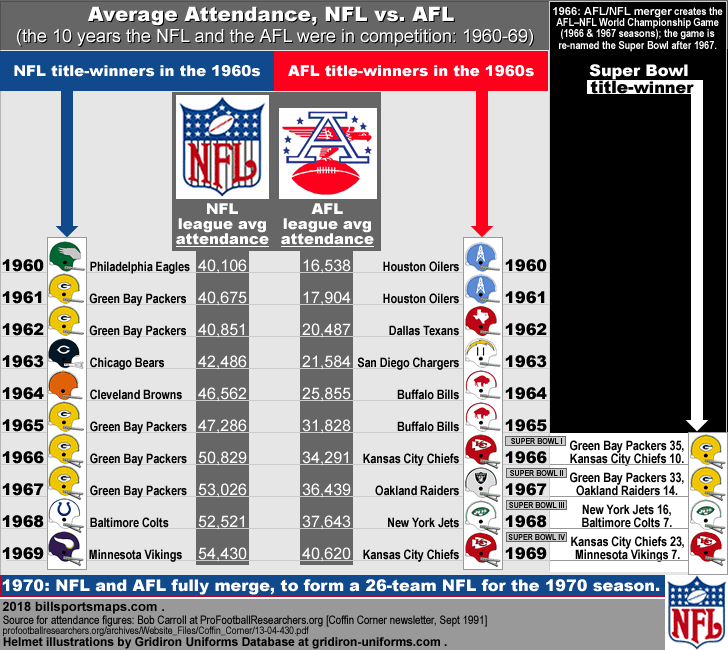
Source for attendance figures: pdf at ProFootballResearchers.org [Coffin Corner newsletter, Sept 1991, by Bob Carroll], profootballresearchers.org/archives/Website_Files/Coffin_Corner/13-04-430.pdf. Helmet illustrations from gridiron-uniforms.com.
And so in the summer of 1966, the NFL headed off the threat of a mutually destructive competition between the two leagues, and negotiated a merger with the AFL. This merger created the Super Bowl in the 1967 season, setting the stage for a full AFL/NFL merger in 1970.
In 1959 there were 12 NFL teams, and absolutely no plans for expansion, despite its ever-growing popularity. And, it must be added, despite the fact that there were a whole host of cities shut out of the NFL and clamoring for expansion teams. In 1970, thanks to the success of the AFL, there were 26 NFL teams…and more to come.
In a ten-year-span, the AFL cut the crowd-size difference between the two leagues by almost ten thousand per game (9.8 K). By 1969, 7 of the 10 AFL teams were drawing over 40-K-per-game (NY Jets at 63 K, Oakland Raiders at 53 K, Kansas City Chiefs at 49 K, Denver Broncos at 46 K, San Diego Chargers at 46 K, Houston Oilers at 44 K, Buffalo Bills at 40 K). The AFL went from drawing a quasi-bush league 16.5-K-per-game in their first season, to drawing a very respectable 40.6-K-per-game in their final season of 1969. That was an increase of over 24,000 per game.
(Source: THE AMERICAN FOOTBALL LEAGUE ATTENDANCE, 1960-69 [pdf].)
And crucially, by the 1968 and 1969 seasons, the AFL became legitimate where it mattered the most…on the field.
In the end, the AFL proved to be the equal of the NFL by the very fact that the last two match-ups between an AFL team and an NFL team ended with the AFL team being the victor. In the 1968 season, the AFL’s New York Jets shocked the sporting world by beating the favored Baltimore Colts in Super Bowl III. And in the 1969 season, the AFL’s Kansas City Chiefs upended the favored Minnesota Vikings in Super Bowl IV.
So in 1970, all 10 teams of the AFL joined the NFL.
This is the only time in the 140-plus-year history of major league sports in the United States and Canada that a competing pro league was fully absorbed into the established pro league, on an equal basis, with no strings attached. Every other such major-leagues-merger was done piecemeal, where the established league got to pick and choose from the rival-league’s roster of teams, and then dictate the terms. Such as with the 8 American Association teams that joined the National League between 1887 to 1892. And such as with the 3 AAFC teams that joined the NFL in 1950. And as with the 4 ABA teams that joined the NBA in 1976. And as with the 4 WHA teams that joined the NHL in 1979. The NFL, circa the late 1950s, had bolted the door on cities like Houston and Boston and Denver and Buffalo and Oakland (and San Diego and Kansas City and Miami). But a decade later, they had to let the whole lot of them in.
57 minute video: Rebels with a Cause: the Story of the American Football League (video uploaded by FWP Film Network at youtube.com).
…
1960: original AFL teams from the Northeast (Boston Patriots, New York Titans, Buffalo Bills). [Boston Patriots changed name to New England Patriots in 1971; New York Titans changed name to New York Jets in 1963]. Shown on the map-segment below are all the venue-locations of the Patriots franchise, the Bills franchise, and the Titans/Jets franchise (1960-2018).
Original helmets, and primary logos, shown. With all locations the teams have played in (1960-2018).

…
1960: original AFL teams from the Southwest (Houston Oilers, Dallas Texans [II]) [Houston Oilers (1960-96) moved to Memphis, TN (1997), and then to Nashville, TN (1998) and became the Tennessee Titans (1999); Dallas Texans (1960-62) moved to Kansas City, MO in 1963, and became the Kansas City Chiefs.].
Original helmets, and primary logos, shown. Shown on the map-segment below are all the venue-locations of the Texans/Chiefs franchise, and the Oilers/Titans franchise (1960-2018).
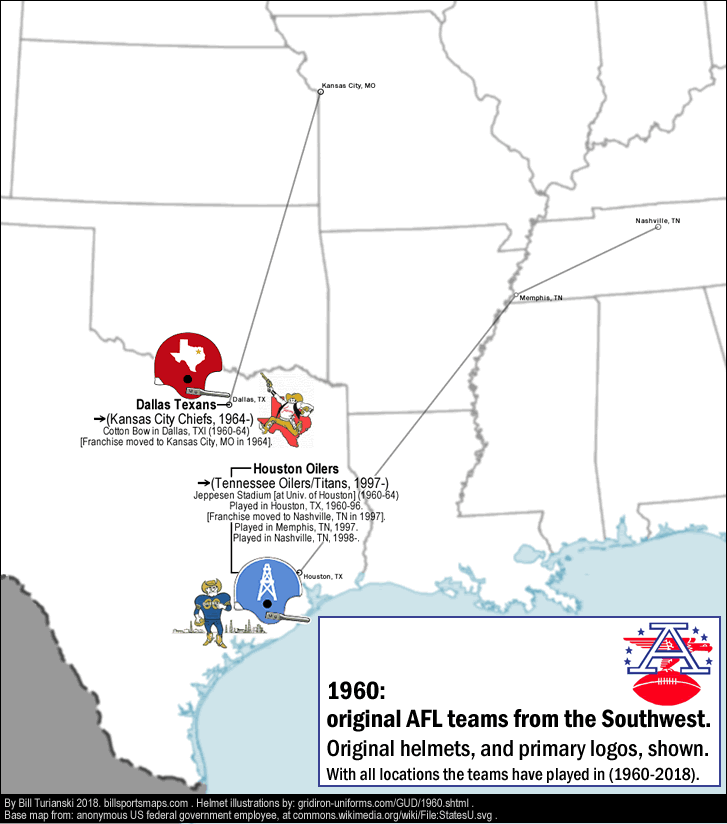
…
1960: original AFL team from the Mountain West (Denver Broncos).
Original helmet, and primary logo, shown.
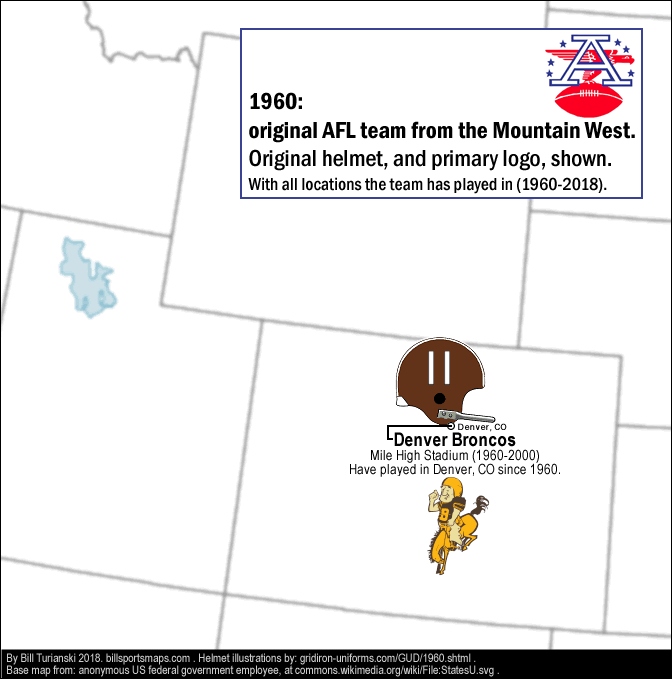
…
1960: original AFL teams from the West Coast (Los Angeles Chargers, Oakland Raiders) [Los Angeles Chargers (1960) moved to San Diego in 1961 (San Diego Chargers 1961-2016), and then moved back to Los Angeles in 2016; Oakland Raiders moved to Los Angeles in 1982 (Los Angeles Raiders 1982-94), and then moved back to Oakland in 1995]. Original helmets, and primary logos, shown. Shown on the map-segment below are all the venue-locations of the Chargers franchise, and the Raiders franchise (1960-2018).
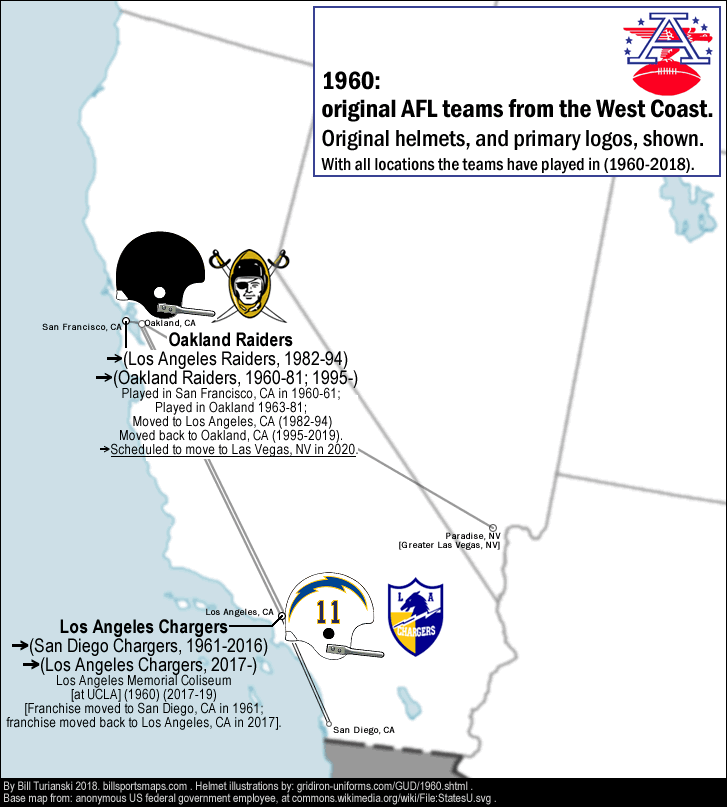
…
- Houston Oilers, the 1960 AFL champions…

Photo and Image credits above – Chargers and Oilers 1960 helmets/jerseys by gridiron-uniforms.com/[1960 AFL title game]. George Blanda (close-up shot) screenshot from Full Color Football #1 uploaded by TheAFLHistory at youtube.com. George Blanda takes a snap in 1960 AFL title game, photo unattributed at fs64sports.blogspot.com/2010/01/1961-oilers-defeat-chargers-for-first-[afl-title-game]. Billy Cannon, photo unattributed at fanbase.com. Blanda to Cannon for 88-yrad-TD, 3 screenshots from Full Color Football #1 uploaded by TheAFLHistory at youtube.com. Oilers 1960 uniform, illustration by Gridiron Uniforms Database: gridiron-uniforms.com/[Seasons/1960/AFL/Oilers]. Shot from Oiler 1961 training camp, photo by NFL/Getty Images via smithsonianmag.com/history/the-american-football-leagues-foolish-club.
___
Houston Oilers, on map page
Screenshot of AFL founders, Hunt and Adams, from video uploaded by Rusty Brewer at youtube.com.
Oilers players on bench [photo circa 1961], screenshot from Full Color Football #1 uploaded by TheAFLHistory at youtube.com. Reproduction of 1960-61 Houston Oilers helmet, photo from supersportscenter.com. George Blanda [image from 1962], screenshot from Full Color Football #1 uploaded by TheAFLHistory at youtube.com. George Blanda [photo circa 1961], photo unattributed at fs64sports.blogspot.com. Billy Cannon [circa 1960 photo, later colorized by John Turney], unattributed at pinterest.com but originally from nflfootballjournal.blogspot.com. Billy Cannon and Rich Michael [photo circa 1961], photo unattributed at profootballhof.com. Dave Smith [photo from 1961], photo by Hy Peskin/Getty Images via gettyimages.com. Al Jamison [1961 Fleer trading card], unattributed at pinterest.com. Mark Johnston [photo from 1960], photo by Neil Leifer/Getty Images via gettyimages.com. Bill Groman [1961 Fleer card], from amazon.com.
…
Offensive stats leaders on map page,
Frank Tripucka, [1961 Fleer trading card], from tradingcarddb.com. Tom Flores [1961 Fleer trading card], from footballcardgallery.com. Al Dorow [photo from 1st Titans game v Buffalo at Polo Grounds], photo by Ernie Sisto/New York Times at nytimes.com. Abner Haynes, [photo circa 1962], photo unattributed at pinterest.com. Bill Groman [photo from 1960 AFL title game (on Jan. 1 1961)], photo by Darryl Norenberg via espn.com. Art Powell [photo from 1960 versus Oilers at Polo Ground], photo by Neil Leifer/Getty Images via gettyimages.com.
…
Thanks to,
-Blank map by anonymous US federal government employee, at File:StatesU.svg (commons.wikimedia.org).
-Thanks to Sportslogos.net for 1960-era AFL team logos. -Thanks to Buffalo Bills official site for original Bills logo (1960-61). -Thanks to Infinite Jets blog for hard-to-find full-color NY Titans logo.
-Thanks to the Pro Football Researchers.org, via their Coffin Corner newsletter, for this THE AMERICAN FOOTBALL LEAGUE ATTENDANCE, 1960-69 [pdf].
-pro-football-reference.com.
-Thanks to the contributors at AFL 1960 season (en.wikipedia.org).
Special thanks to Tim Brulia, Bill Schaefer and Rob Holecko of The Gridiron Uniform Database, for giving billsportsmaps.com the permission to use football uniforms illustrations from Gridiron Uniform Database {GUD}.







